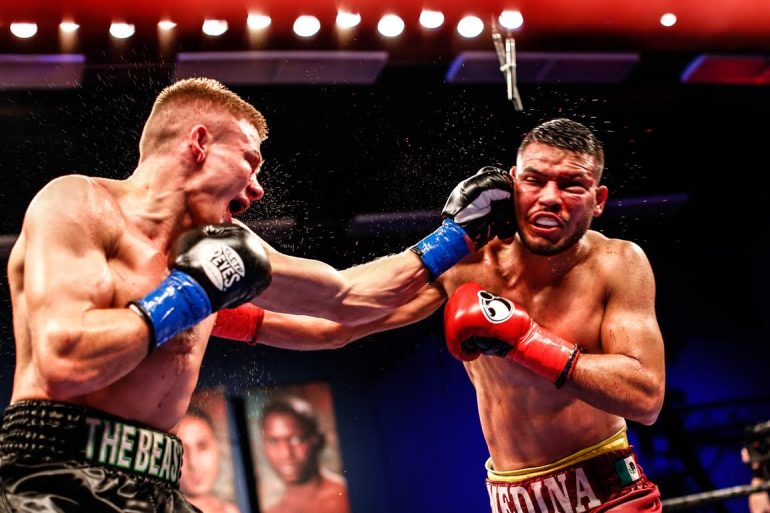
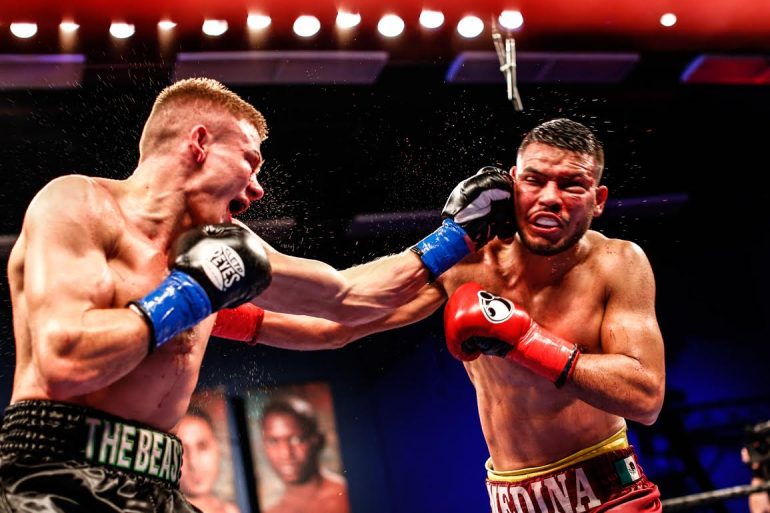
ringtv.com
Friday, Feb. 10 (continued): So who says movie fights can’t happen in real life?
Not anyone who saw Ivan Baranchyk and Abel Ramos slug it out over 10 titanic rounds inside the Buffalo Run Casino in Miami, Oklahoma. It was a fight that had all the cinematic fixings: Extraordinary two-way action, multiple shifts of momentum, a third round that saw both men hit the canvas and a breathtaking finishing kick by each combatant. Both fighters’ faces bore witness to the brutal punishment they absorbed: Baranchyk, who followed up his third round knockdown by scoring another in the fourth, was cut over and under the right eye while both of Ramos’ eyes were horribly swollen and accompanied by cuts over and under the left orb. Yet they fought…and fought…and fought even more.
It was a display of raw pugnacity that would have prompted Sylvester Stallone’s Rocky Balboa and Carl Weathers’ Apollo Creed to nod in recognition and acceptance. But not only that, it probably would have earned the same reaction from real-life ring warriors such as Arturo Gatti and Micky Ward, whose trilogy will forever live in ring lore and whose legacy was ignited by their classic first fight. Amazingly, the numbers for Ward-Gatti I and Baranchyk-Ramos are comparable statistically and, in some cases, the more modern fight came out on top.
First, Ward-Gatti I produced a combined 618 total connects (350 for Gatti, 268 for Ward) while Baranchyk-Ramos racked up 664 (350 for Ramos, 314 for Baranchyk). Second, Ward and Gatti exchanged 1,329 total punches (779 for Gatti, 550 for Ward) to 1,533 for Baranchyk-Ramos (832 for Ramos, 701 for Baranchyk). Third, Ward and Gatti attempted 907 power shots (495 for Gatti, 412 for Ward) to 949 for Baranchyk and Ramos (500 for Baranchyk, 449 for Ramos). Fourth, Ward-Gatti I recorded 521 power connects (296 for Gatti, 225 for Ward) to 482 for Baranchyk-Ward (257 for Baranchyk, 225 for Ramos). Also, the percentages for all four men were close: 45% overall, 60% power for Gatti and 49% overall, 55% power for Ward; 45% overall, 51% power for Baranchyk and 42% overall, 50% power for Ramos.
Finally, the ninth round of Ward-Gatti I was called the “Round of the Century” by Emanuel Steward the instant it finished and it has stood the test of time. Here’s why: They combined for 110 total connects (68 for Ward, 42 for Gatti), 168 total attempts (93 for Ward, 75 for Gatti), 102 power connects (60 for Ward, 42 for Gatti) and 143 power attempts (82 for Ward, 61 for Gatti). Round eight of Baranchyk-Ramos, the most chaotic of their bout, stacks up quite nicely: 104 total connects (55 for Ramos, 49 for Baranchyk), 200 total attempts (113 for Ramos, 87 for Baranchyk), 94 power connects (49 for Ramos, 45 for Baranchyk) and 176 power attempts (99 for Ramos, 77 for Baranchyk). In short, when compared to round nine of Ward-Gatti I, the eighth round of Baranchyk-Ramos had six fewer overall connects, four fewer combined attempts, eight fewer power connects but 32 more power attempts.
The lone set of stats that round nine of Ward-Gatti owns outright over round eight of Baranchyk-Ramos is accuracy: Ward’s incredible leads of 73%-56% overall and 73%-69% power as opposed to Baranchyk’s percentage gaps of 56%-49% overall and 58%-50% power.
But as good as Baranchyk-Ramos was, as a fight, it will never generate the worldwide recognition or historic regard Ward-Gatti I rightfully received. Gatti was already a superstar warrior whose exploits would eventually land him in the International Boxing Hall of Fame while neither Baranchyk nor Ramos was well-known even to hardcores. By beating Gatti at his own vicious toe-to-toe game, Ward’s majority decision win lifted him to a new stratosphere, in terms of recognition by the general public. His grittiness in the ring, his blue-collar life outside it and his earnest honesty created countless new fans worldwide, so much so that a movie of his life was released in 2010. Like Stallone’s initial installment of the “Rocky” series, “The Fighter” was critically acclaimed, earning seven Academy Award nominations (including Best Picture and Best Director) and winning Oscars for Best Supporting Actor (Christian Bale’s portrayal of Dicky Eklund) and Best Supporting Actress (Melissa Leo’s Alice Eklund-Ward, Dicky and Micky’s mother).
It’s impossible to imagine that Baranchyk or Ramos will even come close to Hollywood’s radar or lead to two more fights that netted millions for Gatti and Ward. But as a fight, a pure fight, Baranchyk-Ramos can stand proudly beside Ward-Gatti I in the annals of 140-pound mayhem.
Had it not been for the wildly exciting main event, the opening TV fight between super featherweights Jon Fernandez and Ernesto Garza III would have netted “Fight of the Night” awards on most cards. Instead, it served as a highly entertaining precursor.
From start to finish, the elongated 5-foot-11 Fernandez and the fireplug 5-foot-4 ½ Garza generated fistic pyrotechnics as they combined for 180 total punches (94-86 for Fernandez), 59 total connects (35-24 for Fernandez) and 57 landed power shots (34-23 for Fernandez). The numbers would have been even higher had Fernandez not scored a knockdown with a beautifully executed eight-punch combination.
The second round was even more tumultuous as they swapped 200 punches (101-99 Garza), 77 total punches (44-33 Fernandez), 166 power attempts (90-76 Garza) and 68 landed power punches (35-33 Fernandez). Fernandez’s searing uppercuts propelled Garza’s head upward in almost cartoonish fashion but his fighting spirit (and strong legs) somehow kept him upright.
Fernandez continued to rip away at his smaller target throughout the third. While Garza’s heart was still willing, the attrition became too much and referee Gary Ritter stepped in at the correct moment. The numbers backed up his decision, for, in round three, Fernandez out-threw (86-58) and out-landed Garza by wide margins (35-13 overall, 8-0 jabs, 27-13 power). Fernandez’s third-round effort extended his leads to 114-70 overall, 18-1 jabs and 96-69 power but the real source of his success was his accuracy gaps (42%-28% overall, 21%-3% jabs, 52%-32% power). In the third, those gulfs were 41%-22% overall, 25%-0% jabs and 50%-27% power.
When I counted two of Fernandez’s previous fights, as part of CompuBox’s pre-fight research, I perceived him to be one who scored his knockouts more by attrition than explosive one-punch power. That may still happen against higher-quality opponents but, against the wondrously determined Garza, his punches, especially his uppercuts, possessed genuine snap. Also, Fernandez retained his high-octane output of past fights as he averaged 106.2 punches per round to Garza’s 99.2. While Fernandez earned the right to move upward, I definitely would like to be ringside to see Garza fight again. While his pro record eroded, his regard should be elevated.
The middle bout of the telecast, much like the stereotype regarding middle children, suffered by comparison. The eight-round light heavyweight bout between Joseph Williams Jr. and Lenin Castillo – won by Williams on majority decision – was one played out in two distinctive parts. The first three rounds saw the taller and more mobile Castillo dictate range with his busy jab that helped him forge connect leads of 33-28 overall and 19-12 jabs. But starting in round four, Williams closed the gap, landed the consistently harder punches in the trenches and reduced Castillo to a one-dimensional clutch artist with an emptying gas tank. The holding became so chronic that points could have – and probably should have – been deducted.
While the first five rounds were extraordinarily even statistically (48-46 Castillo overall, 22-22 jabs, 26-24 power), Williams pulled away in the final three rounds as he led 34-22 overall, 5-3 jabs and 29-19 power. He was the far more active fighter, during that stretch (48.7 punches per round to Castillo’s 27) and his punches carried more weight shot-for-shot. Most importantly, Williams neutralized the jab that had flummoxed him in the first nine minutes, for, while Castillo landed 19 jabs in the first three rounds, he connected on just six in rounds 3-8, including none in rounds four and eight.
Williams’ stretch drive led to connect leads of 80-70 overall, 27-25 jabs and 53-45 power, as well as a majority decision that should have been unanimous. But while Williams was the much more active fighter (46.6 per round to Castillo’s 35), Castillo was the more accurate puncher in all categories (25%-21% overall, 17%-16% jabs, 33%-26% power). While precision is a great asset, it also needs to be accompanied by sufficient activity to maximize its impact. Castillo wasn’t able to do that and, thus, he lost. As for Williams, he defeated his best opponent to date, away from his home base and thus deserves to move up another rung.
After emailing the last of the stats to Showtime’s Matt Donovan and CompuBox President Bob Canobbio, I packed my belongings, chatted a bit with ringsiders and joined the others in the customary post-fight pizza feed. As was the case earlier with stage manager Bob Spurck, I gladly chauffeured ring announcer Thomas Treiber back to his hotel.
Once I returned to my room, I went into the business office to check into my flights and print out my boarding passes. (A surprise: Even though I was 10 hours into the 24-hour online check-in window, I was still able to dramatically improve my seating situation on both flights. Thank you, Gold status.) I then purchased a bottle of Coke Zero from the lobby’s mini-market, after which I took the elevator up to my second floor room to upload the night’s stats into CompuBox’s master database. Given the card’s excitement, it took me until 2 a.m. to finally wind down to the point where I could turn out the lights and get some sort of shuteye.
Saturday, Feb. 11: Anxious to get cracking on my writing, I arose after four-and-a-half hours of spotty rest, completed the usual morning routines and spent the next three hours writing most of the words you see here. When I got to a good stopping point, I checked out and headed to the parking lot to begin the long drive to Tulsa.
When I requested my flights for this trip several weeks earlier, I purposely asked for a mid-afternoon departure to account for the drive to Tulsa’s airport as well as give myself ample time to complete most of my writing before boarding the first plane. The latter objective was completed shortly before 10 a.m., so I was in a great frame of mind, by the time I climbed into the silver Nissan Rogue.
I couldn’t have asked for better driving weather: Sunny skies and a 71-degree temperature – a far cry from the winter wonderland I left two days earlier. Thankfully, as I type this, my hometown of Friendly, West Virginia, had recovered nicely; though under a mostly cloudy sky, the temperature was a relatively toasty 51 degrees.
But in exchange for the massive leap forward in work production, I would be coming home at a very late hour. The itinerary for this day was to take a 2:34 p.m. flight from Tulsa to Dallas-Fort Worth and a 6:25 p.m. bird to Pittsburgh that, if all went well, would arrive at 9:59 p.m. EST. If one includes the 30-minute trip to my car, I’d be getting home around 1 a.m.
After filling up my rental’s gas tank at a QT station just minutes outside the airport and dropping it off at the Avis lot, I walked into the terminal and looked at the flight monitor. Thanks largely to the 75 mph limit on Interstate 44, I had made such tremendous time, that I could theoretically board the 12:30 p.m. flight to Dallas Fort-Worth, which was just 15 minutes from departing. Better yet, both my original 2:34 p.m. bird and this flight were set to leave from the identical gate. So, I decided to roll the dice.
The dice rolled right. Yes, my seat would be on the exit row, which meant I would be asked to assist in case of an unlikely emergency but my reward would be ample space to stretch my legs and store my laptop bag underneath the seat in front of me. Also, even if I couldn’t find an earlier flight back to Pittsburgh, DFW was an excellent airport to spend a few extra hours.
Less than 20 minutes after approaching the gate, my first flight of the day took off. As has been the case with every flight I’ve taken thus far, no life-threatening emergencies occurred. In fact, this flight was particularly smooth and it was so brief (around 45 minutes) that I had to gulp down my cold glass of Coke Zero, so I could beat the final pass of the trash bag.
I can do many things but guzzling soda isn’t one of them. Still, I managed to do so just seconds before the flight attendant reached my seat but, as I dumped my trash, my eyes burned from the brain freeze.
With a few hours to kill at DFW, I took a long, leisurely lunch while reading my latest literary companion: “Once There Were Giants: The Golden Age of Heavyweight Boxing” by Hall of Fame writer Jerry Izenberg, a book that was highly recommended to me by several friends.
When I wasn’t reading, I was conversing. One of the people with whom I spoke was a woman who lived 20 minutes south of Pittsburgh, who was in Dallas to visit her son, who happened to be an air-traffic controller at DFW. Coincidentally, a few minutes after our plane departed, the pilot got on the loudspeaker and made special mention of one passenger, a woman whose son just arranged for our plane to be granted a “shortcut” to Pittsburgh. The new flight path reduced our flight time by 10 minutes, which is pretty significant when one is traveling between 500 and 600 mph.
Thanks to a significant warm-up in the “Steel City,” the snow that had been so prevalent two days earlier was long gone. The only evidence it had even been there was scattered puddles of muddy slush around the wheels of some cars, including mine.
Once I paid the parking bill, I turned on the area’s classic rock station – “3WS,” 94.5 on your FM dial – and drove into the night. Thanks to the shortcut and the fact I didn’t make my usual food stop, I pulled into the driveway at 12:31 a.m., nearly a half-hour earlier than anticipated.
As usual, a pile of work awaited me. I’ll spend the next five days whittling it down and hopefully it will be at a more manageable level by the time I leave for my next trip. Then, as NFL coaching legend Bill Belichick would say, “I’m on to Cincinnati.”
Until then, happy trails!

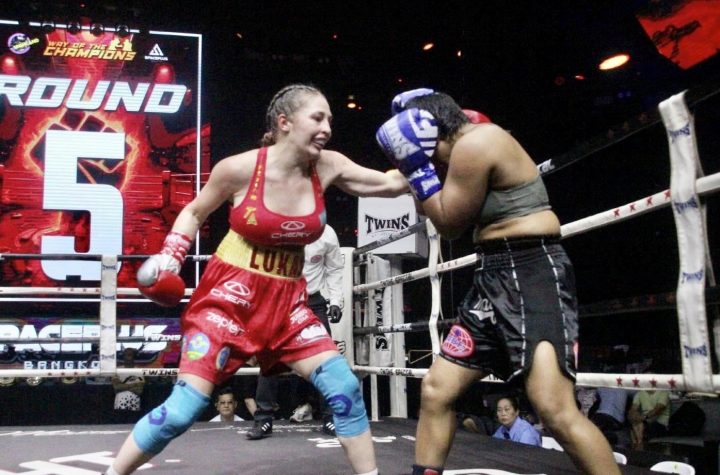
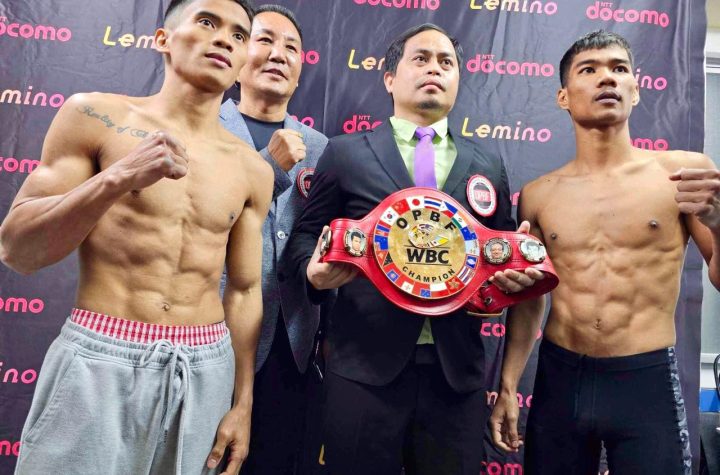
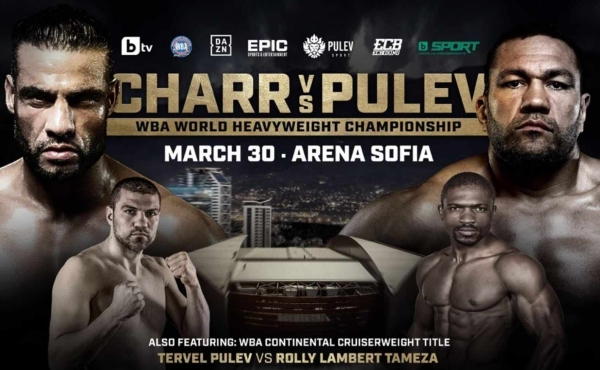
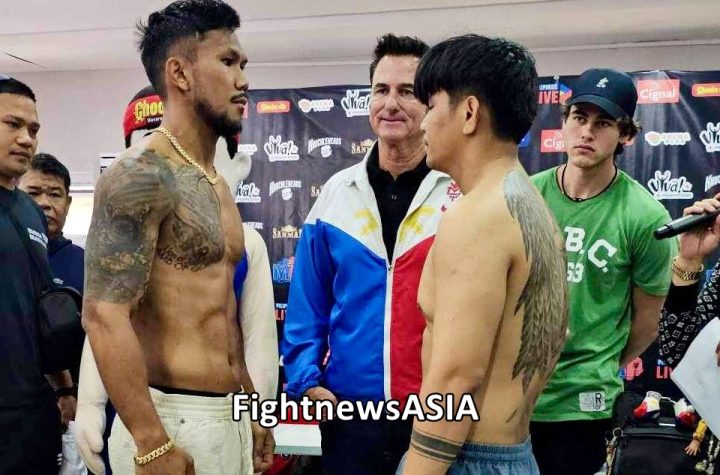
More News
Marcial vs Sinam in Manila
Era, Lukas, Innes Win in Thailand
Vitor vs Kim in Bohol